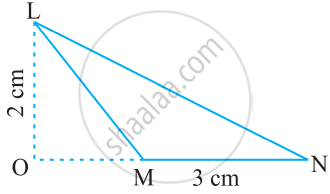Advertisements
Advertisements
प्रश्न
Show that the points A (3,1) , B (0,-2) , C(1,1) and D (4,4) are the vertices of parallelogram ABCD.
उत्तर
The points are A (3,1) , B (0,-2) , C(1,1) and D (4,4)
Join AC and BD, intersecting at O.

We know that the diagonals of a parallelogram bisect each other `".Midpoint of AC" = ((3+1)/2 , (1+1)/2) = (4/2,2/2) = (2,1) `
`"Midpoint of BD " ((0+4)/2 , (-2+4)/4) = (4/2,2/2) = (2,1)`
Thus, the diagonals AC and BD have the same midpoint
Therefore, ABCD is a parallelogram.
APPEARS IN
संबंधित प्रश्न
A(4, - 6), B(3,- 2) and C(5, 2) are the vertices of a 8 ABC and AD is its median. Prove that the median AD divides Δ ABC into two triangles of equal areas.
Find the area of the triangle whose vertices are: (2, 3), (-1, 0), (2, -4)
Determine the ratio in which the line 2x + y – 4 = 0 divides the line segment joining the points A(2, – 2) and B(3, 7).
Find the area of a triangle with vertices at the point given in the following:
(1, 0), (6, 0), (4, 3)
Find equation of line joining (1, 2) and (3, 6) using the determinant.
Find equation of line joining (3, 1) and (9, 3) using determinant.
Find the area of a triangle whose vertices are
(6,3), (-3,5) and (4,2)
Show that the points (-3, -3),(3,3) and C (-3 `sqrt(3) , 3 sqrt(3))` are the vertices of an equilateral triangle.
Find the area of the following triangle:

A(6, 1), B(8, 2) and C(9, 4) are three vertices of a parallelogram ABCD. If E is the midpoint of DC, find the area of ∆ADE.
